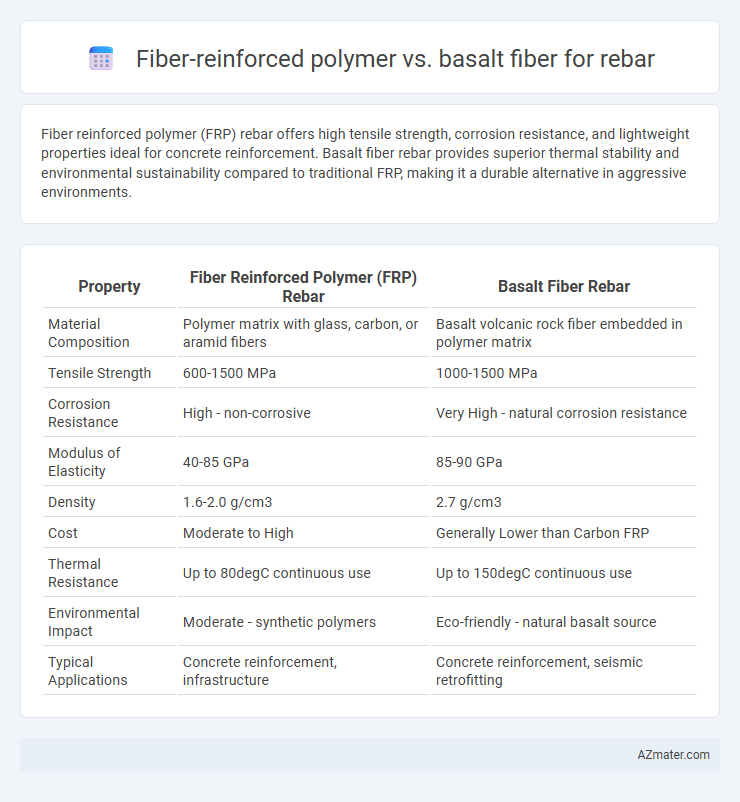Fiber reinforced polymer (FRP) rebar offers high tensile strength, corrosion resistance, and lightweight properties ideal for concrete reinforcement. Basalt fiber rebar provides superior thermal stability and environmental sustainability compared to traditional FRP, making it a durable alternative in aggressive environments.
Table of Comparison
| Property | Fiber Reinforced Polymer (FRP) Rebar | Basalt Fiber Rebar |
|---|---|---|
| Material Composition | Polymer matrix with glass, carbon, or aramid fibers | Basalt volcanic rock fiber embedded in polymer matrix |
| Tensile Strength | 600-1500 MPa | 1000-1500 MPa |
| Corrosion Resistance | High - non-corrosive | Very High - natural corrosion resistance |
| Modulus of Elasticity | 40-85 GPa | 85-90 GPa |
| Density | 1.6-2.0 g/cm3 | 2.7 g/cm3 |
| Cost | Moderate to High | Generally Lower than Carbon FRP |
| Thermal Resistance | Up to 80degC continuous use | Up to 150degC continuous use |
| Environmental Impact | Moderate - synthetic polymers | Eco-friendly - natural basalt source |
| Typical Applications | Concrete reinforcement, infrastructure | Concrete reinforcement, seismic retrofitting |
Introduction to Fiber Reinforced Polymer (FRP) and Basalt Fiber Rebars
Fiber Reinforced Polymer (FRP) rebars are composite materials made from a polymer matrix reinforced with fiber strands such as glass, carbon, or aramid, offering high strength-to-weight ratios and corrosion resistance in concrete reinforcement. Basalt fiber rebars, derived from volcanic basalt rock, provide superior mechanical properties, excellent thermal stability, and enhanced durability compared to traditional steel and other FRP types. Both FRP and basalt fiber rebars serve as advanced alternatives for reinforced concrete structures, aiming to improve service life and structural performance in harsh environments.
Material Composition: FRP vs Basalt Fiber
Fiber reinforced polymer (FRP) rebar primarily consists of continuous fibers such as glass or carbon embedded in a polymer resin matrix, typically epoxy or vinyl ester, providing high strength-to-weight ratios and corrosion resistance. Basalt fiber rebar, derived from molten basalt rock, features a natural volcanic mineral composition that offers excellent chemical stability and superior alkali resistance in concrete environments. The material composition differences lead to variations in mechanical properties, durability, and environmental impact between FRP and basalt fiber rebars.
Mechanical Properties and Strength Comparison
Fiber reinforced polymer (FRP) rebar, primarily composed of glass or carbon fibers, offers high tensile strength and excellent corrosion resistance, making it ideal for reinforcing concrete structures in harsh environments. Basalt fiber rebar, derived from natural volcanic basalt, demonstrates superior mechanical properties such as higher tensile strength, better impact resistance, and improved durability compared to traditional glass FRP but slightly lower stiffness than carbon FRP. Both materials outperform steel in corrosion resistance, with basalt fiber rebar providing a cost-effective balance of strength and durability for infrastructure applications requiring long-term performance.
Durability and Corrosion Resistance
Fiber reinforced polymer (FRP) rebar and basalt fiber rebar both offer superior durability and corrosion resistance compared to traditional steel rebar, making them ideal for harsh environments. Basalt fiber rebar exhibits excellent chemical stability and high resistance to alkali and acid attacks, ensuring long-term performance in concrete structures. FRP rebar, composed of glass or carbon fibers embedded in a polymer matrix, resists moisture and chlorides effectively, preventing corrosion-related deterioration and extending service life significantly.
Weight and Density Differences
Fiber reinforced polymer (FRP) rebars typically exhibit a density around 1.8 g/cm3, while basalt fiber rebars have a slightly higher density near 2.6 g/cm3, impacting overall weight and handling. The lower density of FRP rebars offers a significant weight advantage, reducing structural loads and easing installation compared to basalt fiber rebars. Despite basalt fiber's increased weight, it provides enhanced thermal stability and mechanical properties, making it a choice for specific high-performance applications.
Cost and Economic Considerations
Basalt fiber rebar generally offers a lower upfront material cost compared to fiber-reinforced polymer (FRP) rebar, making it an economically attractive option for budget-sensitive construction projects. The manufacturing process of basalt fibers is less energy-intensive, leading to cost savings and improved environmental impact metrics. Long-term economic benefits of basalt fiber include higher durability and corrosion resistance, reducing maintenance expenses and extending the lifespan of reinforced concrete structures.
Installation and Handling Characteristics
Fiber reinforced polymer (FRP) rebars are lightweight and corrosion-resistant, making them easier to transport and handle on site compared to traditional steel. Basalt fiber rebars offer superior toughness and impact resistance, ensuring less risk of damage during installation. Both materials require cutting and bending techniques compatible with their unique mechanical properties to maintain structural integrity during handling.
Environmental Impact and Sustainability
Fiber reinforced polymer (FRP) rebars, typically made from glass or carbon fibers embedded in a polymer matrix, offer corrosion resistance and reduced maintenance but rely heavily on non-renewable petrochemical resources, leading to higher carbon footprints compared to natural alternatives. Basalt fiber rebars, derived from abundant volcanic rock, provide a more sustainable option due to their low energy consumption during production, recyclability, and non-toxic nature, significantly reducing environmental impact. Life cycle assessments highlight basalt fiber rebars' advantages in minimizing greenhouse gas emissions and promoting eco-friendly infrastructure development.
Performance in Various Construction Applications
Fiber reinforced polymer (FRP) rebars exhibit superior corrosion resistance, high tensile strength, and lightweight properties, making them ideal for marine and chemical-exposed environments. Basalt fiber rebars offer excellent thermal stability and enhanced impact resistance, providing durability in high-temperature and seismic-prone construction sites. Both materials outperform traditional steel in preventing corrosion-related failures, with basalt fiber showing better sustainability due to its natural origin.
Conclusion: Choosing Between FRP and Basalt Fiber Rebars
Fiber reinforced polymer (FRP) rebars offer excellent corrosion resistance and high tensile strength, making them ideal for environments with aggressive chemical exposure. Basalt fiber rebars provide superior thermal stability and eco-friendly benefits due to their natural basalt mineral composition, which enhances durability and sustainability in construction. Selecting between FRP and basalt fiber rebars depends on project-specific factors such as environmental conditions, mechanical property requirements, and long-term performance goals.

Infographic: Fiber reinforced polymer vs Basalt fiber for Rebar
 azmater.com
azmater.com